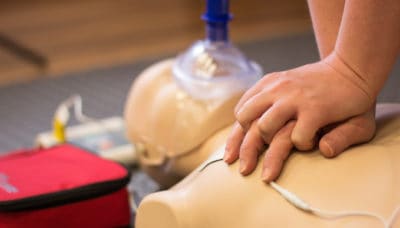Introduction
In our fast-paced world, emergencies can strike without caution. Whether it's a minor injury, a medical emergency situation, or a deadly circumstance, understanding how to give first aid can make all the difference. This is where a First Aid course enters into play. Many individuals may wonder what they can obtain from such training, and this post intends to shed light on that.
By joining in a First Aid and CPR course, you do not just find out about bandaging injuries or carrying out CPR; you equip yourself with important abilities that might save lives. So, just what will you find out in a detailed program? Allow's study the details.
First Help Fundamentals: What You'll Find out in a Detailed Course
Understanding First Aid
What is First Aid?
First aid refers to the preliminary aid provided to somebody suffering from an injury or health problem until specialist clinical help gets here. It encompasses various techniques and abilities varying from simple injury care to lifesaving methods like mouth-to-mouth resuscitation (Cardiopulmonary Resuscitation).
Importance of Emergency treatment Training
Why Should You Take an Emergency Treatment Course?
Taking a First Help course is essential for several factors:
- Confidence: Recognizing exactly how to respond in emergency situations can instill confidence. Life-Saving Skills: The capacity to carry out mouth-to-mouth resuscitation or help with choking can save lives. Career Advancement: Lots of occupations call for qualification in initial aid. Community Obligation: Learning means you can aid others effectively.
Overview of CPR
What is CPR?
CPR, or Cardiopulmonary Resuscitation, is an emergency situation procedure executed when somebody's heart beat or breathing has quit. It incorporates breast compressions with rescue breaths to maintain blood circulation and oxygenation First Aid Course Sydney until specialist aid arrives.
The Structure of a Comprehensive Emergency Treatment Course
What Does a First Aid Course Include?
A well-rounded First Aid and mouth-to-mouth resuscitation course generally covers the following subjects:
Introduction to First Aid Legal and Moral Considerations Scene Safety Basic Life Support (BLS) CPR Techniques Choking Relief Wound Treatment Management Burn Treatment Managing Shock Recognizing Medical Emergencies Using an Automated External Defibrillator (AED)Legal Aspects of First Aid
Are There Legal Ramifications Associated With Offering First Aid?
Yes, supplying first aid does bring lawful obligations called "Do-gooder legislations." These legislations shield people that help others in emergency situations, offered their activities are reasonable and not reckless.
Scene Safety and security: The Initial Step
How Do You Guarantee Scene Safety?
Ensuring scene safety and security entails analyzing the atmosphere before approaching the sufferer:

- Look for possible risks (web traffic, fire). Make sure it's risk-free for both you and the victim.
Basic Life Support (BLS)
What Role Does BLS Play in Emergency Situations?
Basic Life Support consists of the principles of keeping life features up until further clinical help shows up. This section covers vital abilities such as:
- Checking responsiveness Activating emergency situation services Performing top quality upper body compressions
Advanced CPR Techniques
What Are Advanced Techniques Covered in Mouth-to-mouth Resuscitation Courses?
Advanced methods might consist of:
- Two-rescuer CPR Use of obstacle devices for rescue breaths Special considerations for infants and youngsters
Choking Alleviation Techniques
How Do You Assist A Person That is Choking?
Choking alleviation involves 2 important strategies:
The Heimlich maneuver for adults. Back blows and chest drives for infants.Wound Treatment Management
How Do You Effectively Take Care Of Wounds?
Effective wound monitoring entails:
- Cleaning the wound with saline or tidy water. Applying antibiotic ointment. Covering it with sterile dressings.
Burn Treatment
What Work Techniques for Dealing With Burns?
Burn therapy differs by level:
Cool the burn under running water. Cover it with non-stick dressings. Seek medical attention for serious cases.Managing Shock
How Is Shock Identified and Treated?
Recognizing shock includes seeking signs like light skin, quick pulse, or confusion:
Lay the person down. Elevate their legs unless there are injuries avoiding this. Keep them soothe up until assistance arrives.Recognizing Medical Emergencies
What Kinds of Medical Emergencies Ought To You Understand Of?
Common medical emergency situations consist of:
- Heart strikes Stroke Severe allergic reactions Recognizing these problems helps you act quickly.
Using an Automated External Defibrillator (AED)
How Do You Use an AED Correctly?

Using an AED involves transforming it on, attaching pads according to illustrations on the tool, and following voice prompts carefully.

Importance of Continuous Learning
Why Is Constant Discovering Important in First Aid Training?
Continuous understanding guarantees you stay updated on best methods and brand-new protocols in first aid care.
FAQs Regarding First Aid Courses
What Is Included in a Standard First Aid Course?- A common course usually covers fundamental life support, wound administration, choking relief methods, and legal considerations.
- Most training courses range from 6 hours to 16 hours relying on the depth of web content covered.
- Yes, upon successful completion of the majority of programs, participants obtain a first help certificate, which is usually valid for 2 years.
- Yes! Lots of companies offer online training courses that give adaptable knowing atmospheres while still being effective.
- Absolutely! Hands-on technique is essential for grasping abilities like breast compressions and utilizing AEDs effectively.
- Generally, there are no age limitations; nevertheless, participants need to be emotionally competent to find out these life-saving skills effectively.
Conclusion
Enrolling in a detailed emergency treatment course equips individuals with essential expertise that can conserve lives during emergencies-- whether in your home, work, or out in public spaces! From recognizing basic life assistance treatments like CPR to learning how to manage wounds properly or recognize indicators of shock-- these courses supply invaluable training that anybody can benefit from!
As we browse via our lives full of unpredictability-- what much better way than preparing ourselves with understanding gained from structured training sessions concentrated on saving lives?
In verdict-- if you're considering using up any type of kind of first-aid training-- never ever wait! Equip yourself today with these powerful tools because readiness genuinely makes all the distinction when every second counts!